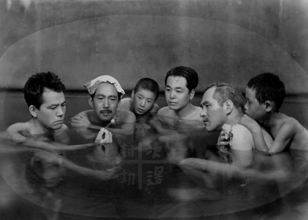Ornamental Hairpin
Shimizu Hiroshi
Japan 1941

|
" Arsenal 13.02. 15.30 |
Produktion: Shochiku (Ofuna)
Filmquelle: Kollektion des National Film
Center, National Museum of Modern Art, Tokyo
Buch: Shimizu Hiroshi, nach dem Roman von
Ibuse Masuji
Kamera: Ikai Suketaro
Ausstattung: Motoki Isamu
Ton: Nakamura Koichi
Musik: Asai Taka-aki
Darsteller: Tanaka Kinuyo, Kawasaki Hiroko, Saito
Tatsuo, Ryu Chishu, Himori Shin-ichi
Format: 35mm, 1:1.37, s/w
Länge: 70 Minuten, 24 Bilder/Sek.
Sprache: Japanisch
Based on the Ibuse Masuji short story 'The Four Bathtubs', Shimizu weaves a tale of a group of guests who are spending the summer at a hot spring. Despite being made during wartime, Ornamental Hairpin is a big-hearted story sure to raise a chuckle. The guests assembled at the hot spring – a difficult scholar, an old man and his two grandchildren, a newlywed couple, and a returned soldier called Nomura who has an injured leg – have no more than a passing acquaintance with each other until one day, Nomura stands on a woman’s hairpin in the bath and hurts his foot. Emi, the owner of the hairpin, comes all the way from Tokyo to apologise. For some reason, Emi appears to be in no hurry to return to the city, and extends her stay, joining the children to help Nomura practise walking. The summer ends and everybody leaves, but what happens to Emi? Shimizu was highly regarded by the other master filmmakers of his era. Ozu Yasujiro, a close friend who was born in the same year, once declared: ”I can’t shoot films like Shimizu,” while Mizoguchi Kenji is quoted as saying: ” People like me and Ozu get films made by hard work, but Shimizu is a genius.” Disliking anything contrived, Shimizu preferred to improvise in his films, making frequent use of children and location shots and weaving lyrical stories that used Japan’s natural surroundings to maximum effect. The works of Shimizu Hiroshi are unique: full of wit and humour, and possessing a rare and special charm all their own.
Shimizu Hiroshi (1903-1966). Seit seinem 21. Lebensjahr Regisseur, insgesamt 163 Filme: historische wie zeitgenössische Werke, Melodramen, Komödien, Filme über einheimische Stoffe, Studentensportfilme, Ninjo-Filme (über menschliche Gefühle) sowie Dokumentarfilme. Er gilt – zusammen mit Ozu Yasujiro – als einer der wegweisenden japanischen Regisseure seiner Zeit.